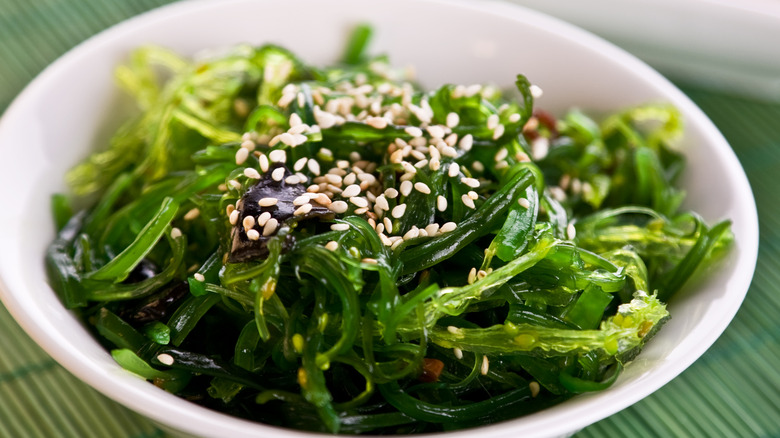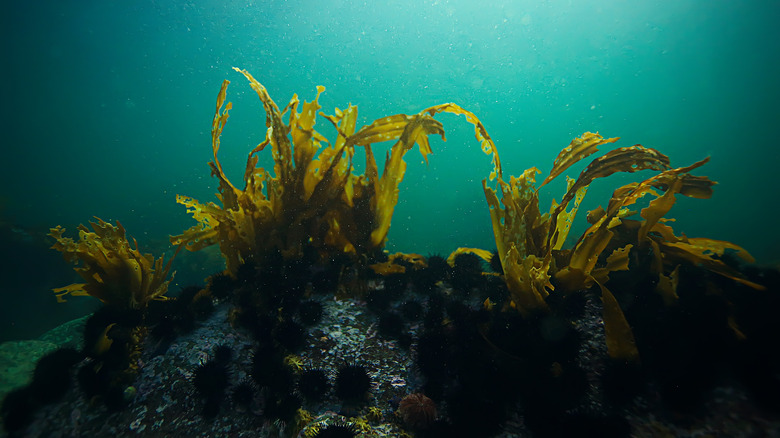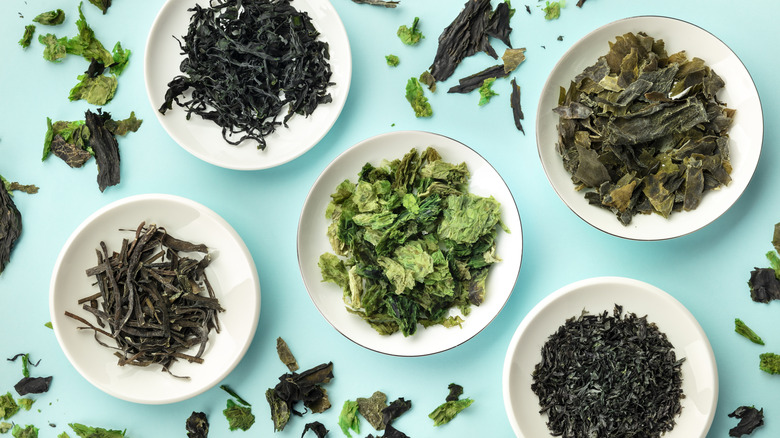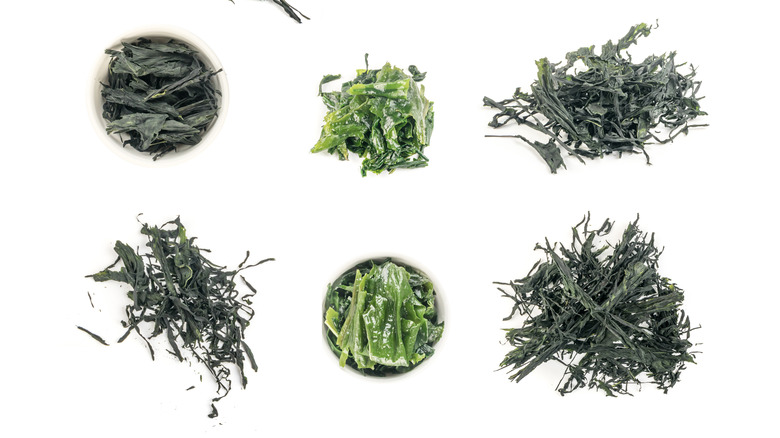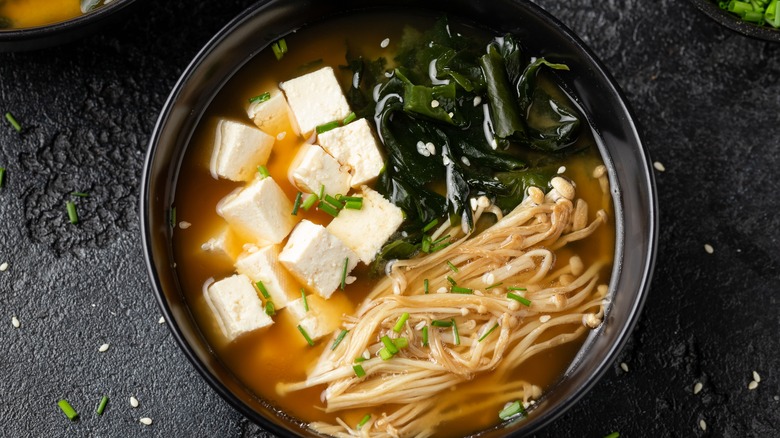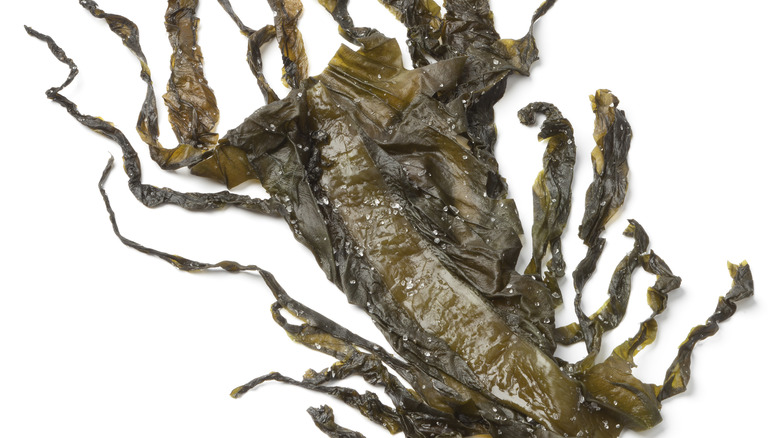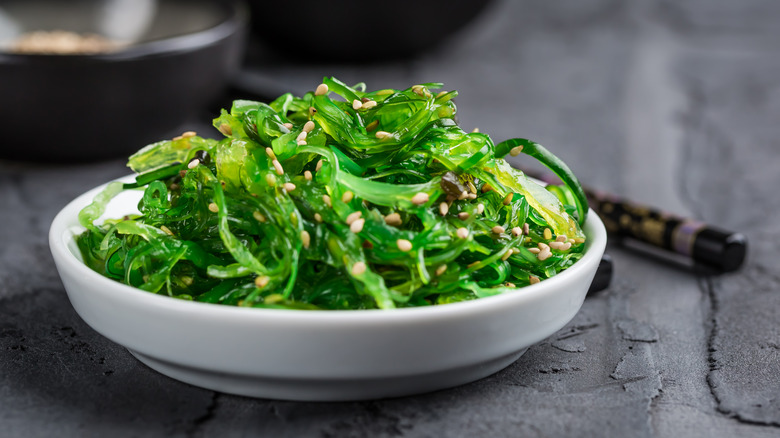Wakame Is The Japanese Superfood Your Diet Needs
If you've ever been to a Japanese restaurant and ordered a bowl of miso soup, you've probably already had wakame — the soft, salty, lightly sweet sea kelp traditionally used in the dish alongside chopped scallions, cubed tofu, dashi stock, and miso paste. Wakame, whose scientific name is Undaria pinnatifida, is one of many edible seaweeds used around the world, and is most often associated with Japanese cuisine.
Don't dismiss wakame, however, as just another ingredient in a bowl of soup. It's a low-fat, nutrient-dense superfood that could be a boon to anyone's pantry as a heart-healthy staple, loaded with Omega-3 fatty acids. Wakame is at home in both soups and salads, and is always a healthy addition.
Below, a breakdown of what wakame is, how it differs from other well-known edible seaweeds, its flavor profile and how to procure and cook it. Because the more you know about wakame, the sooner you'll be putting it in your shopping cart.
What is wakame?
Wakame is a sea vegetable, native to the cold temperate Pacific waters of northeast Asia, specifically the coastal regions of Japan, Korea, China, and Russia. Its Undaria genus is part of the broader Alariaceae family of brown kelp which includes at least one other edible member, Alaria. Wakame is a dark, brownish green kelp, ultimately taking on the appearance of a spear blade when it reaches its full height of between four and 6½ feet. For their part, the Japanese have been harvesting it for over 1,500 hundred years.
If there is a downside to wakame, its that it has a habit of taking over new ecological habitats — to the extent that it's now included in the top one hundred of the world's worst invasive alien species list. Apparently, the kelp hitches rides to new lands by attaching itself to ship hulls, forming dense forests wherever it lands and then causing competition with native plants and animals for light and space.
Comparing wakame to other edible seaweeds
You might be wondering what the difference is between wakame and other seaweeds like nori and kombu. The simple answer is texture. Wakame is bright green and smooth; unlike kombu, it is thin and has a refreshing flavor. It's different from nori and aonori in that it comes frozen, pickled, or most commonly, dehydrated in small strips that look something like an oceanic raisin until reconstituted.
When rehydrated, wakame looks a lot like a fresh leafy green, earning it the name "sea mustard" because of its similarity in look and flavor profile to that of mustard greens. Wakame is like a more delicate, softer alternative of kombu, and both are packed with umami flavor. While ogo might be the closest to wakame in its purposes (like soups and salads), wakame is a preferable option for many as it doesn't have a slimy mouth feel like ogo.
More about wakame's umami goodness
The simplest description of wakame's assertive flavor is briny-sweet. It is an oceanic vegetable, after all, and thus embodies the wonderful minerally, salty qualities of the sea. It pulses with umami — the deep, savory flavor often called "the fifth taste." For the chemistry-minded, umami denotes a combination of amino acids, specific nucleotides, and minerals. For the rest of us, we're talking about a meaty, almost bacon-like quality of toothsome complexity. Either way: savory deliciousness.
Because it is available almost exclusively dried, the texture of reconstituted wakame is, well, seaweedy: satiny and a little slippery. In other forms, wakame stems and leaves appear as snack food: boiled, dried, grilled, pickled, or even made into crackers. The dried, seasoned snack variety is a little chewier than potato chips. With regard to both flavor and texture, rehydrated dried wakame is virtually indistinguishable from fresh.
How to cook with wakame
Wakame is most commonly employed in dishes like miso soup and seaweed salads. It will have to be reconstituted if you're using dried wakame. This is done by soaking strips in warm water for about 10 minutes. Do note that wakame grows significantly when rehydrated, so start with a pinch or two for most recipes. You may even consider breaking some of your dehydrated strips up to make the reconstituted wakame easier to manage after it has bloomed in your water. This method is most common when preparing it for soups.
If you're going to use wakame in a salad, you'll need to blanch it first. This is done by simply putting the wakame in boiling water for a couple minutes, draining, and putting it into ice water. Be sure to squeeze any excess liquid out of the wakame before using. Blanching will help retain it's bright green color, making it a very appealing base for a seaweed salad.
Where to buy wakame
You're guaranteed to find both dried wakame and various snack incarnations in Asian grocery stores, particularly those which specialize in Japanese products. It's also possible to order blanched, salt-preserved wakame directly from Japan. These typically come from specific regions of cultivation, such as the swift whirlpools of the Tokushima Naruto Channel. In fact, all wakame cultivated in Japan's Seto Inland Sea is highly prized for its bright green color, mild flavor, and sweeter taste.
Given its omnipresence in miso soup, wakame is commonly seen in the international or Asian food aisles of most supermarkets. It's also available online in nearly any form imaginable — flaked, whole leaf, dried, hand-harvested, or included in pre-made miso soup packs. Although harvested in late winter or early spring, there is no real seasonality to dried wakame; it has a shelf life of at least several months or even a year.
Wakame nutrition and health benefits
Wakame is a nutrient-dense food, low in calories and high in vitamins and minerals like A, C, E, K and even iron, copper and phosphorus. It contains iodine and tyrosine, which have been shown to support thyroid function. There is some evidence that wakame and other seaweeds can help maintain a healthy cholesterol and blood pressure. Wakame is high in antioxidants and phytonutrients, making it an effective anti-inflammatory, helping reduce risk for heart disease and certain kinds of cancer.
Like everything in life, you can have too much of a good thing. While adding wakame to your diet regularly will help you reap its nutritional benefits, do note that it is high in sodium. If you are currently taking a synthetic thyroid hormone, it is always advisable to talk to your healthcare provider before incorporating seaweed as a regular part of your diet.
